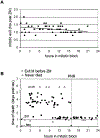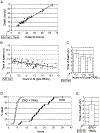Length of mitotic arrest induced by microtubule-stabilizing drugs determines cell death after mitotic exit
- PMID: 19509263
- PMCID: PMC12337704
- DOI: 10.1158/1535-7163.MCT-08-1084
Length of mitotic arrest induced by microtubule-stabilizing drugs determines cell death after mitotic exit
Abstract
Cell death induced by agents that disrupt microtubules can kill cells by inducing a prolonged mitotic block. This mitotic block is dependent on the spindle assembly checkpoint, a surveillance system that ensures the bipolar attachment of chromosomes to the mitotic spindle before the onset of anaphase. Under some conditions, the spindle assembly checkpoint can become weakened, allowing cells to exit mitosis despite the presence of chromosomes that are not properly attached to the mitotic spindle. Here, we use an Aurora kinase inhibitor to drive mitotic exit and test the effect of mitotic arrest length on death in the subsequent interphase. Cells that are blocked in mitosis for >15 h die shortly after exiting from mitosis, whereas cells that exit after being blocked for <15 h show variable fates, with some living for days after exiting mitosis. Cells blocked in mitosis by either Taxol or epothilone B are acutely sensitive to the death ligand tumor necrosis factor-related apoptosis-inducing ligand, suggesting that prolonged mitosis allows the gradual accumulation of internal death signals, rendering cells hypersensitive to additional prodeath cues. Death under these conditions is initiated while cyclin B1 is still present, indicating that cells are in mitosis. Our experiments suggest that there is a point of no return during prolonged mitotic block after which mitotic exit can no longer block death.
Figures







Similar articles
-
The Black Book of Psychotropic Dosing and Monitoring.Psychopharmacol Bull. 2024 Jul 8;54(3):8-59. Psychopharmacol Bull. 2024. PMID: 38993656 Free PMC article. Review.
-
When the Clock Is Ticking: The Role of Mitotic Duration in Cell Fate Determination.Bioessays. 2025 Aug 30:e70061. doi: 10.1002/bies.70061. Online ahead of print. Bioessays. 2025. PMID: 40884189 Review.
-
The ability to survive mitosis in the presence of microtubule poisons differs significantly between human nontransformed (RPE-1) and cancer (U2OS, HeLa) cells.Cell Motil Cytoskeleton. 2009 Aug;66(8):437-47. doi: 10.1002/cm.20316. Cell Motil Cytoskeleton. 2009. PMID: 18792104 Free PMC article.
-
MZ3 can induce G2/M-phase arrest and apoptosis in human leukemia cells.J Cancer Res Clin Oncol. 2008 Dec;134(12):1337-45. doi: 10.1007/s00432-008-0416-0. Epub 2008 May 20. J Cancer Res Clin Oncol. 2008. PMID: 18491135 Free PMC article.
-
A rapid and systematic review of the clinical effectiveness and cost-effectiveness of paclitaxel, docetaxel, gemcitabine and vinorelbine in non-small-cell lung cancer.Health Technol Assess. 2001;5(32):1-195. doi: 10.3310/hta5320. Health Technol Assess. 2001. PMID: 12065068
Cited by
-
Phosphorylation of Mcl-1 by CDK1-cyclin B1 initiates its Cdc20-dependent destruction during mitotic arrest.EMBO J. 2010 Jul 21;29(14):2407-20. doi: 10.1038/emboj.2010.112. Epub 2010 Jun 4. EMBO J. 2010. PMID: 20526282 Free PMC article.
-
Transient tissue priming via ROCK inhibition uncouples pancreatic cancer progression, sensitivity to chemotherapy, and metastasis.Sci Transl Med. 2017 Apr 5;9(384):eaai8504. doi: 10.1126/scitranslmed.aai8504. Sci Transl Med. 2017. PMID: 28381539 Free PMC article.
-
Pharmacologic inhibition of the anaphase-promoting complex induces a spindle checkpoint-dependent mitotic arrest in the absence of spindle damage.Cancer Cell. 2010 Oct 19;18(4):382-95. doi: 10.1016/j.ccr.2010.08.010. Cancer Cell. 2010. PMID: 20951947 Free PMC article.
-
The Consequences of Chromosome Segregation Errors in Mitosis and Meiosis.Biology (Basel). 2017 Feb 8;6(1):12. doi: 10.3390/biology6010012. Biology (Basel). 2017. PMID: 28208750 Free PMC article. Review.
-
A new class of cytotoxic agents targets tubulin and disrupts microtubule dynamics.Bioorg Chem. 2021 Nov;116:105297. doi: 10.1016/j.bioorg.2021.105297. Epub 2021 Aug 30. Bioorg Chem. 2021. PMID: 34509798 Free PMC article.
References
Publication types
MeSH terms
Substances
Grants and funding
LinkOut - more resources
Full Text Sources
Miscellaneous

